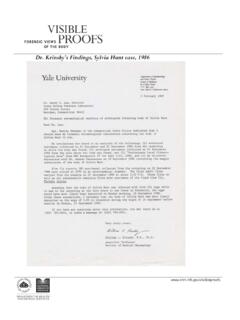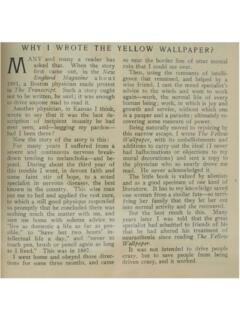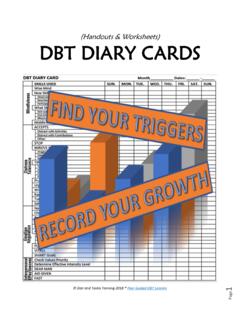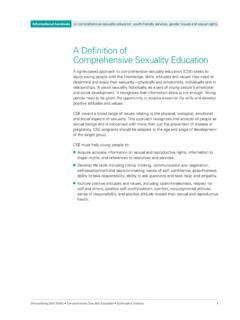Transcription of Science & Society: Preventing the Spread of Disease lesson ...
1 Science & society : Preventing the Spread of Disease Grade Level: 6-12 grades (a teacher-guided approach for younger students and a student-directed approach for older students). Description: Students are introduced to vocabulary, and their prior knowledge about infectious diseases is assessed. They conduct a liquid exchange activity that models a Spread of an infectious Disease . An activity summary discussion helps students extend and apply their understanding of how an infectious Disease may Spread . Students work in small groups to examine real-life cases of infectious diseases from different countries and diverse approaches in solving the health problems caused by infectious diseases. Students learn about people and organizations that help prevent the Spread of infectious diseases. Students also consider how to balance protecting the rights of those who have infectious Disease and those who do not.
2 Learning Outcomes: Students will be able to: Simulate the Spread of an infectious Disease ( lesson 1). Describe some factors essential in the prevention of an infectious Disease ( lesson 1). Identify health challenges and solutions in various case studies ( lesson 2). Apply their understanding of the Spread of Disease and prevention methods to health problems relevant to themselves or their communities ( lesson 2). Time Needed: Two 45-minute class periods Vocabulary: Disease : a disorder or incorrectly functioning organ, part, structure, or system of the body;. Disease can result from genetic or developmental errors, infection, poisons, nutritional deficiency or imbalance, toxicity, or unfavorable environmental factors; an abnormal condition Germ: a microorganism that causes Disease Infect: affect, contaminate, or taint Infectious: tending to Spread from one to another Organism: a living being, a form of life considered an entity Symptom: a sign or indication of something Transmit: to send, Spread , or pass on Transmission: the act or process of spreading Materials: lesson 1.
3 Disposable 4 oz. or medicine cups for all students and a few extras for a teacher demonstration Aprons and goggles for all students One or two plastic droppers or glass pipettes with squeezable tops (for teacher only). Calculator Handouts for students: Word Scramble Game, Word List and Questions, Exchange Activity Notes, Exchange Activity Summary Teacher's keys and discussion highlights for student handouts: Teacher's Word Scramble Game, Teacher's Word List and Questions, Teacher's Exchange Activity Notes, Teacher's Exchange Activity Summary Alkaline (basic) solution: Add teaspoon or about 1 gram of sodium hydroxide (NaOH) to a half liter of tap water for a mild concentration, approximately mole. pH indicator: phenolphthalein (C 20 H 14 O 4 ), which turns alkaline solutions pink. lesson 2. Case Studies: Diarrheal diseases, HIV/AIDS: Ryan White, Smallpox, Malaria Handouts for students: Case Study Notes, Preventing Infectious Diseases Teacher's keys and discussion highlights for student handouts: Teacher's Case Study Notes, Teacher's Preventing Infectious Diseases Page 1.
4 lesson 1 Procedures: Preparation before the class: Number each cup for identification. Randomly select three cups and fill each one-third full with the sodium hydroxide solution. Record these cups' numbers for your reference later on. Fill the rest of each cup one-third full with tap water. Cut several Word Scramble Game sheets into single rows or groups of rows so that there are as many cutouts as the number of student pairs for each class. Building vocabulary 1. Have students work in pairs and provide each pair with a cutout of the Word Scramble Game. Ask student pairs to use the hints and definitions to unscramble letters to spell a word in each row of their cutouts. 2. Place a blank Word Scramble Game transparency on an overhead projector and have students share their answers. Activating prior knowledge 3.
5 Place a blank Word List and Questions transparency on an overhead and conduct a brief discussion using the questions on the transparency to assess students' prior knowledge and assumptions about infectious germs and diseases. Record student responses and correct any misconceptions , contagious vs. inherited illnesses. Discussion notes for teachers are provided on the Teacher's Word List and Questions. Simulation the Spread of Disease 4. Inform students that they will use these words and the discussion points after conducting an exchange activity that simulates how an infectious germ may be transmitted quickly from one person to another. 5. Provide each student with a numbered cup pre-filled with a liquid (see alkaline solution preparation in Materials section above and an Exchange Activity Notes handout. 6. Place the Exchange Activity Notes transparency on an overhead projector and review the following key steps of the activity before students start their exchange activity: a.)
6 Exchange liquid by pouring liquid from one cup into the other, then dividing the mixture evenly into the two cups (step 3). b. Exchange your liquid with three other students, one at a time (step 3). c. Record who (cup numbers), when (first, second or third) and what (color) for all three exchanges (steps 3 and 5). 7. Have students conduct the exchange activity and record data on the handout, following the steps in the Exchange Activity Notes. Consider whether the activity should be teacher-guided or student-directed. The Teacher's Exchange Activity Notes provides guided facilitation and review- discussion suggestions for both options. Debriefing of the simulation activity 8. Have students summarize their exchange activity using their completed Exchange Activity Notes. 9. Tell students that the phenolphthalein (C 20 H 14 O 4 ) that you added to their cups (activity step 5) is a pH indicator that turns pink in a basic/alkaline solution (pH greater than 7).
7 If appropriate, introduce or review that pH measures the acidity (lower than 7) or alkalinity (greater than 7). of a solution. 10. Demonstrate how phenolphthalein (C 20 H 14 O 4 ) stays clear in tap water with a neutral pH level (7), but turns pink in an alkaline sodium hydroxide (NaOH) solution. 11. Tell students that you handed out three cups with sodium hydroxide solution and that the rest contained tap water, at the beginning of the activity. Page 2. Applying and extending 12. Distribute a copy of the Exchange Activity Summary sheet to each student. 13. Place a blank Exchange Activity Summary transparency on an overhead projector and fill out letters a and c on the top of the transparency as a whole class. 14. Put students in small groups (3-4 per group) to complete the Summary sheet. 15. Collect completed sheets and tell students that each group will present their summary during the next class.
8 lesson 2 Procedures: Discussion 1. Return students' Exchange Activity Summary sheets collected from lesson 1 and have students review their notes. 2. Place a blank Exchange Activity Summary transparency on the projector. And have groups share their notes and summarize them on the transparency. Use the notes provided in the Teacher's Exchange Activity Summary to extend the discussion to consider: essential knowledge for Preventing the Spread of Disease protecting the rights of all people those who have infectious diseases and those who do not possible misuse of health information to discriminate Case studies 3. Tell students that they will work on real-life cases that demonstrate different ways to prevent the Spread of an infectious germ. 4. Divide students into four or more small groups and assign one of the following case studies to a group: a.
9 Diarrheal diseases b. HIV/AIDS-Ryan White c. Smallpox d. Malaria 5. Hand out copies of the assigned case study and the Case Study Notes sheet to each student to work in their small groups and complete the Case Study sheet. 6. Have each group present their completed Case Study Notes to the class. Use the notes on the Teacher's Case Study Notes to help students consider multiple perspectives of understanding and solving health problems. Summation 7. Distribute a copy of Prevention of Infectious Diseases Worksheet to each student. Direct students to complete the five sentences on the top half of the worksheet. Have students share their responses and refer to the notes on Teacher's Prevention of Infectious Diseases for discussion points. 8. Have students write a paragraph responding to a question How can you help prevent the Spread of infectious Disease ?
10 At the bottom half of the worksheet. 9. Collect the completed Prevention of Infectious Diseases Worksheet write-ups for evaluation. Evaluation: lesson 1: Review student responses to items 1-3 on the Exchange Activity Summary to evaluate students' understanding of the simulation activity. This will also provide some clarifications and corrections that should be addressed in the next class. lesson 2: The group presentation of the Case Study Notes can be used to evaluate the students'. understanding of diverse ways of Preventing the Spread of infectious diseases, how solutions to health problems may differ from place to place, and how everyone can participate in the prevention of infectious Disease . Also, review students' completed Prevention of Infectious Diseases write-ups to evaluate how they have applied what they have learned to their own lives.


















